|
September 10,
2002

Click here for the rest of this week's NorthEast
Radio Watch
By SCOTT FYBUSH
The transmitter rooms at the top of One World Trade
Center were a busy place a year ago this week - as busy,
in fact, as they'd been in the quarter-century since New
York's TV stations and several of its FM outlets made
the north tower home to their main transmitters, largely
supplanting the shorter Empire State Building as the
city's primary TV transmission facility.
The arrival of digital TV to the New York market, and
the impending FCC deadline to get DTV construction
permits on the air, made for a busy summer up there,
1400 feet above lower Manhattan. In July, WNBC-DT and
WABC-DT had been the first of the Trade Center DTVs to
sign on, quickly followed by the other digital TV
signals that were sharing a new panel antenna on the
huge mast that crowned the north tower, WPIX-DT, WNET-DT
and WWOR-DT. (The last two Trade Center DTV signals,
WPXN-DT and WNJU-DT, had yet to sign on.)
Millions of dollars had been invested in refitting
the transmitter rooms to accomodate the additional
equipment for the DTV conversion in the nation's biggest
TV market, providing for the extra power and cooling the
new transmitters needed.
By that mid-September morning, most of the work had
been completed. But there was always someone in most of
the big transmitter rooms, even early in the morning,
and on that particular day six engineers were settling
in for their daily routines in their transmitter rooms:
Isaias Riveras and Bob Pattison in the 110th floor space
of WCBS-TV (which was analog-only from WTC; its DTV
facilities were up at Empire), William Steckman down on
104 at WNBC/WNBC-DT, Donald DiFranco at WABC-TV/DT on
110, Steve Jacobson down the hall at WPIX-TV/DT, and Rod
Coppola watching the transmitters of WNET-TV/DT
nearby.
They would be among the nearly 3,000 lives lost that
morning, at least some of their transmitters running
almost to the very end, broadcasting the pictures of
their own buildings burning. But by the time the north
tower collapsed, with the TV antenna plummeting through
clouds of dust to the ground below, the screens of most
New York viewers without cable had gone nearly
empty.
With the help of some never-before-published FCC
documents, this week's NERW will tell the story of how
the New York dial began to return to normal in the days
and weeks that followed September 11.
Tuesday, September 11: Panic
The TV broadcasters who used the Trade Center
believed they were prepared for just about any
eventuality: they all had multiple transmitters and
copious sources of backup power at the north tower. The
idea that the tower itself would cease to exist was so
far-fetched as not to figure in any emergency plans, and
as a result only one of the WTC TV stations had an
auxiliary facility elsewhere.
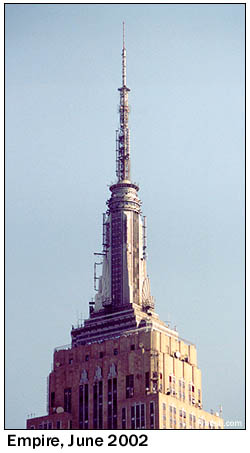 WCBS-TV
(Channel 2) had put that aux site, its pre-1975 primary
location at the Empire State Building, to use once
before, when the bombing of the Trade Center basement in
1993 put the transmitters there out of commission for
several hours. In 2001, the space at Empire was being
used primarily for WCBS-DT (Channel 56), which had beat
its competitors on the air by several years as a result
of choosing Empire over WTC. A 35 year old Harris analog
transmitter still sat there, though, and when the
channel 2 signal from WTC finally went dark, WCBS-TV was
back on the air in minutes from Empire at more than half
its Trade Center power. (Its signal would also be seen
nationwide for much of the day on the VH1 cable network,
owned by parent company Viacom.) WCBS-TV
(Channel 2) had put that aux site, its pre-1975 primary
location at the Empire State Building, to use once
before, when the bombing of the Trade Center basement in
1993 put the transmitters there out of commission for
several hours. In 2001, the space at Empire was being
used primarily for WCBS-DT (Channel 56), which had beat
its competitors on the air by several years as a result
of choosing Empire over WTC. A 35 year old Harris analog
transmitter still sat there, though, and when the
channel 2 signal from WTC finally went dark, WCBS-TV was
back on the air in minutes from Empire at more than half
its Trade Center power. (Its signal would also be seen
nationwide for much of the day on the VH1 cable network,
owned by parent company Viacom.)
For the other broadcasters who had used the Trade
Center, cable (for those viewers in New York City and
nearby Cablevision areas whose systems had direct fiber
links to the broadcasters) and satellite became the only
way to reach viewers at first. Even the remaining New
York "superstation," WPIX (Channel 11), lost its
national satellite feed for a few hours; its microwave
link to the uplink site had been at WTC.
Within a few hours after the attack, WABC-TV (Channel
7) had begun feeding its signal to several UHF stations
with working sites. The school system's WNYE-TV (Channel
25) and home shopping WHSE (Channel 68), both on Empire,
began to carry WABC's commercial-free programming by
early afternoon, joined later on by the New Jersey
Network's WNJN (Channel 50) in Montclair, N.J. (WHSE's
sister station, WHSI in Smithtown, Long Island, on
channel 67, also carried ABC programming beginning in
mid-afternoon; there were also reports, never confirmed,
that Long Island public television station WLIW on
channel 21 was carrying some WABC programming.)
The WNBC (Channel 4) signal found its way back on the
air, for some viewers at least, via WMBC (Channel 63) in
Newton, N.J.; that station also was seen with some
programming from Fox's WNYW (Channel 5).
Radio was also knocked out by the attacks: the Trade
Center had been home to Columbia University's WKCR
(89.9), Spanish Broadcasting's WPAT-FM (93.1 Paterson
NJ), public radio WNYC-FM (93.9) and Clear Channel's
WKTU (103.5 Lake Success). Only WKTU had a
fully-functional auxiliary site, the recently-completed
Conde Nast building at Four Times Square; it shifted
smoothly from WTC to that site with no downtime.
WKCR and WPAT-FM would remain silent for several
days. WNYC lost more than its FM signal; its
studio-to-transmitter link to WNYC(AM) also ran through
the Trade Center site, leaving no way to get audio from
the station's Municipal Building studios to the
otherwise unaffected AM 820 site across the river in
Kearny, N.J. To make matters worse, the studios were
only a few blocks from the Trade Center, at the top of a
tall building that was soon evacuated.
WNYC returned to the air that afternoon from the
small NPR studio space in midtown Manhattan; its AM
signal was soon restored by sending audio from midtown
Manhattan by ISDN to NPR in Washington, where it was
uplinked to the NPR satellite. A dish was quickly rushed
to New Jersey to receive that signal and get AM 820 back
on the air.
Further help for WNYC came that day from WNYE (91.5),
the school system's station in Brooklyn, which quickly
agreed to begin carrying WNYC programming, an
arrangement that began at noon Wednesday and would stay
in place well into 2002.
By day's end, the TV stations were already making
plans to bring a new site on line to restore at least a
semblance of on-air service.
Wednesday, September 12: Enter Alpine
Seventeen miles north of the smoking ruins of the
Trade Center, high above the bluffs along the western
edge of the Hudson River, the tower built in 1937 by the
inventor of FM radio sits as a prominent landmark above
the Palisades Interstate Parkway and route 9W.
When Major Edwin Howard Armstrong developed the site
for his experimental station W2XMN, it was intended in
part as a slap in the face to NBC and its powerful
chairman, David Sarnoff, who had encouraged Armstrong to
develop FM radio, then withdrawn his support (in favor
of TV development) and the use of NBC's facilities atop
the new Empire State Building, a site that was then
under the exclusive control of NBC.

At the time, the undeveloped land at Alpine was
probably the best alternative to Empire. It was (and is)
some of the highest ground in the metropolitan area,
with a dramatic view that overlooks lower Westchester
County (including Armstrong's family home directly
across the river in Yonkers), the Bronx and northern
Manhattan.
On that site, Armstrong built a massive, three-armed
tower, rising 400 feet above the Palisades, crowning it
with the antenna for his W2XMN. It stayed on the air
there until 1954, when Armstrong took his life, deep in
depression over a nasty patent battle with Sarnoff's
RCA. The tower never came down, instead finding a new
life as a prime perch for communications antennas (and
eventually for WFDU-FM at Fairleigh Dickinson University
as well.)
And with all that space - and plenty of available
power and space for transmitters at the base - Alpine
was the immediate choice for an emergency auxiliary site
for most of the WTC TV stations. By the end of the day
on September 12, Harris and other equipment firms were
already diverting low-powered transmitters and antennas
intended for other clients to New York, along with
engineers to help put them in place at Alpine.
The first station to apply for special temporary
authority from Alpine, on September 12, was none other
than WNBC - and if the irony of Armstrong's tower being
used to keep the station of his erstwhile rival NBC on
the air was noted by anyone at the Peacock Network, it
was soon forgotten in the spirit of cooperation that
united the city's broadcasters.
WNBC was back on the air with 2 kilowatts of visual
power at 207 meters above average terrain late the next
day (Thursday), with equipment on the way as well for
WABC, WPIX (granted STA on September 14 with 6.2 kW
visual at 244 meters), WNET and one of the two UHF
stations that had been on the WTC, Telemundo's WNJU
(Channel 47).
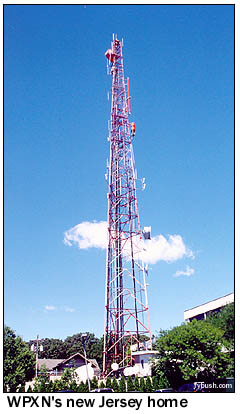 The
last of the Trade Center UHFs, Pax's WPXN (Channel 31),
looked in a different direction that day. The
last of the Trade Center UHFs, Pax's WPXN (Channel 31),
looked in a different direction that day.
Across the Hudson in East Orange, N.J., Pax also
owned LPTV W23BA, which had recently won permission to
change from channel 23 to channel 34. It operated from a
tower at 416 Eagle Rock Avenue that had been the
original home of channel 68 in its days as WBTB, before
it moved to the tip of the Empire State Building.
Before the day was out, Pax filed an emergency STA
request to move W23BA to channel 31 and boost its power
to 240 kW, becoming in effect an auxiliary WPXN facility
(albeit still under the LPTV license).
Pax also had another dormant LPTV, WPXU-LP out in
Amityville on Long Island. WPXU had operated on channel
38, but had gone dark when WWOR-DT began its operations
on that channel over the summer. (WPXU would
subsequently apply to move to channel 19, an application
that was dismissed by the FCC this year.)
In a late-morning e-mail to the FCC, which was itself
in a state of disarray as a result of the chaos in
Washington, Pax asked to be allowed to resume operations
on channel 38, saying it believed WWOR-DT "will not
resume operation soon."
The FCC, fast-tracking as much of the recovery
process as possible, granted both applications as
six-month STAs before the day was out. Covering all the
bases, the FCC even assigned a temporary callsign for
the channel 31 operation. Did anyone in New York ever
know they were watching "W31CK"?
Thursday, September 13 - Saturday, September 15:
The FMs Return, Slowly
With much less space needed for their antennas and
transmitters, the FM stations that lost their facilities
at WTC had a somewhat easier time getting back on the
air.
WPAT-FM, silent since Tuesday morning, spent Thursday
installing a transmitter at the Empire State Building,
feeding the old Alford FM master antenna that rings the
102nd floor observatory. While the Alford had long since
been supplanted for primary use by the ERI master
antenna higher up the mast (on space vacated by the TV
stations' move to the World Trade Center, ironically),
it was still available for auxiliary use by most of the
Empire FMs, though even that use was limited by RF
exposure concerns for observatory visitors. (The need
for a different auxiliary site was what had prompted
Clear Channel to build the 4 Times Square site that kept
WKTU on the air after the attacks.)
But the Alford still worked, and on Friday WPAT-FM
returned to the air with a 719-watt signal from it, on a
six-month STA while the station looked for a permanent
new home. WNYC-FM also returned from the Alford on
Saturday, with an 300-watt mono signal (later boosted to
800) intended as a temporary measure while something
higher-powered was being developed.
As for WKCR, it returned to the air on Friday from
the Columbia University campus in northern Manhattan,
installing one bay of a two-bay ERI antenna on the
station's former STL tower atop Carman Hall, running
just 248 watts in mono from 37.2 meters above average
terrain. It was a far cry from WKCR's huge Trade Center
signal, but it at least put something on the air at
89.9. (It also restored the radio reading service,
In-Touch, that used WKCR's subcarrier.)
Meanwhile, Empire was also being carefully examined
by several of the TV stations that had yet to return to
the air, even at low power. Fox had space at Empire for
its WNYW-DT, channel 44, and by Friday work was underway
to move WNYW's analog channel 5 facility, as well as
recently-purchased sister station WWOR, channel 9, into
that space. (WWOR's signal was also being made available
as a subchannel on WNYW-DT for those lucky New Yorkers
with DTV receivers; in the meantime, CBS had offered
subchannels on WCBS-DT to the city's other
broadcasters.)
WABC-TV returned to the air on Saturday afternoon at
12:50 with a 2 kW signal from Alpine, using a
directional antenna aimed south-southeast at Manhattan;
installed at space on Alpine that had been intended for
its sister station WPLJ (95.5) as an auxiliary facility.
WABC's signal had been dropped from WNYE-TV on Friday
night (WNYE would then become a replacement signal for
sister public broadcaster WNET); WHSE/WHSI and NJN had
also dropped the WABC relay by then.
On Friday, WPIX applied for a 6.2 kW STA signal from
the WABC-TV antenna at Alpine - but at the same time,
the station had been trying some other ways to get
Channel 11 back on the dials of the 30% of New Yorkers
without cable. A low-power transmitter was reportedly
used from the roof of the Daily News Building at 220 E.
42nd Street, home to WPIX's studios, on Tuesday and
Wednesday; by Thursday, WPIX was running 1 kW visual
(with an STA for up to 3 kW) on channel 11 from an
antenna on the north side of the Empire State Building
at the 81st floor.
(NERW suspects the antenna was aimed out a window of
a transmitter room; floors 81 through 85 of Empire are
where the transmitters are located.)
That signal didn't reach south at all, so WPIX went
back to the FCC and asked for permission to reactive the
long-defunct channel 64 translator that once operated
from Empire with 2.5 kW visual. That translator had an
interesting history of its own: when the Trade Center
went up in the seventies, it was feared that the new
signals from its roof would run into multipath problems
in Manhattan and the Bronx. In those uncrowded UHF days,
most of the VHF stations were granted temporary UHF
translators to use to augment their signals - and that's
where channel 64 came from. A verbal STA was granted on
Friday to reactivate that southward-facing signal from
Empire as well.
WNJU resumed its over-the-air broadcasts on channel
47 on Thursday, using a Scala antenna 117 meters up on
the Alpine tower and 10 kW of visual power, leaving WNET
and WWOR as the last stations with no over-the-air
signal during the weekend.
Week of September 17: Searching for Better
Alternatives
The flow of e-mails among stations, engineers,
Washington lawyers and the FCC took a breather on
Sunday, but resumed in earnest Monday morning as
stations tried to improve their weak emergency
signals.
At Alpine, it was becoming clear that the site that
worked so well for Major Armstrong had some new
drawbacks sixty-odd years later. The sheer mass of
skyscrapers in lower and midtown Manhattan that had gone
up since the thirties served as a wall that prevented
the Alpine signals from being seen well, if at all, in
Queens, Brooklyn, Staten Island and out on Long Island.
Viewers in those areas still found themselves with
limited TV choices as the new week dawned, with WCBS
still the only truly reliable VHF signal on the
dial.
On Monday, WNBC boosted its power from 3.2 kW to 15.9
kW from Alpine, with further authorization the following
Friday to go all the way to 52 kW. WABC-TV installed a
second, north-facing panel antenna on Alpine for itself
and WPIX, intended to send at least some signal up
towards Westchester and Rockland counties.
And at WCBS-TV, a retired engineer was brought up
from Florida to look after the old Harris transmitter
that was keeping channel 2 on the air at full power from
Empire. The station procured what was said to be the
last amplifier tube for the transmitter in Harris' stock
of parts, and meanwhile made plans to get a new Harris
Platinum solid-state transmitter in place at Empire to
replace the venerable auxiliary unit that had served it
so well.
STAs were granted on Thursday for WNYW-TV and WWOR-TV
to resume their operation at low power from Empire; on
Friday, WNET became the last of the World Trade Center
broadcasters to get a signal back on the air, using a
Dielectric panel antenna at Alpine to put 5.91 kW visual
on channel 13. It was a weak signal indeed, with
significant nulls toward Manhattan and north Jersey
(including the actual city of license, Newark), and was
upgraded on September 27 to 31.8 kW.
(WNET was aided in early October by the Dish Network
satellite service, which offered to add the station's
signal to its package until the broadcast signal could
be restored, thus restoring WNET service to many
satellite customers in the metropolitan area. WNET also
continued to place some of its programming on WNYE-TV,
from 6-9 AM and 9 PM - 2 AM, throughout October and
November.)
Alpine was also seeing more power from Telemundo's
WNJU, which boosted power to 1338 kW visual from a
Dielectric antenna at 83 meters up on the Armstrong
tower during the week, under an STA it would continue
using until July 2002.
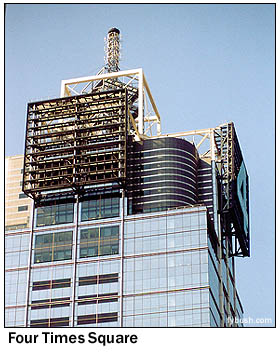 On
the radio side, things were getting back to normal a bit
faster. On Monday, WPAT-FM moved from the old Alford
master antenna (at 1220 feet AAT) to the ERI master,
more than a hundred feet higher, still making 719 watts
ERP from a 100-watt transmitter. On
the radio side, things were getting back to normal a bit
faster. On Monday, WPAT-FM moved from the old Alford
master antenna (at 1220 feet AAT) to the ERI master,
more than a hundred feet higher, still making 719 watts
ERP from a 100-watt transmitter.
WKTU, the best-positioned of the four WTC FMs, kept
boosting its power from Four Times Square, going from 8
kW on Sept. 11 to 9.8 kW on Sept. 14, then applying for
(and being granted) an STA for 17 kW on Sept. 21. The
new signal actually carried beyond the authorized Trade
Center signal in some directions, though it remained
subject to intermodulation problems from the Empire
transmitters in midtown Manhattan. (103.5, under its old
calls of WYNY, had moved in 1991 from a directional
antenna on the south tower of the Trade Center to the
non-directional master antenna on the north tower,
shared with WNYC-FM and WPAT-FM. The north tower master
was originally intended to accommodate most, if not all,
of the FMs then on Empire; with the exception of WNYC-FM
and WPAT-FM, none made that move.)
WNYC-FM and WPAT-FM both began looking at Four Times
Square as well, attracted by the copious transmitter
space and power available, as well as the empty ports on
the FM combiner. On September 28, WNYC-FM was authorized
for a 13 kW STA from the Times Square tower, with
WPAT-FM following suit the next month, applying for and
being granted an 8 kW auxiliary facility there. (WPAT's
sister station, WSKQ-FM 97.9, would also apply for an
aux facility at Conde Nast in early 2002.)
But perhaps the most unusual e-mail to make its way
to the FCC that Monday concerned WNYE-DT, the channel 24
facility licensed to the New York City schools and
operating from the old WNYE-TV (and current WNYE-FM)
site atop Brooklyn Technical High School. The Federal
Emergency Management Agency spent the weekend
corresponding with WNYE-DT about using its facilities
for something other than broadcast television: replacing
its 8-VSB DTV signal with a COFDM data signal.
The idea, quickly endorsed by the FCC in an STA
granted Monday morning, was to use WNYE's digital signal
to carry video and audio to recovery workers at Ground
Zero, aiding in the limited communications
infrastructure at the site. Transmitters and encoders
were quickly rushed to WNYE, and a shipment of small
receivers was soon on the way from the International
Broadcasting Convention in Amsterdam, where they had
been on display.
Back to Empire
 Even
with higher power, Alpine was simply unsuitable for
long-term use, at least in its present form. It was too
low to "see" above Manhattan and reach the populous
boroughs to the south and east and Long Island beyond
that. The stations using the tower began working on
plans to improve the Armstrong facility for long-term
use by late September, beginning with a determination on
September 28 by the Federal Aviation Administration that
adding 100 feet to the top of the tower would pose no
hazard to air navigation. Even
with higher power, Alpine was simply unsuitable for
long-term use, at least in its present form. It was too
low to "see" above Manhattan and reach the populous
boroughs to the south and east and Long Island beyond
that. The stations using the tower began working on
plans to improve the Armstrong facility for long-term
use by late September, beginning with a determination on
September 28 by the Federal Aviation Administration that
adding 100 feet to the top of the tower would pose no
hazard to air navigation.
There was also the neighborhood to take into account,
for while Major Armstrong had Alpine all to himself, his
tower was surrounded six decades later by "McMansions."
Alpine and neighboring Closter had become some of the
toniest communities in north Jersey, with homes almost
in sight of the tower's base fetching well into the
seven figures.
The tower may have been there first (and may have
been revered as a landmark by radio-history buffs), but
the neighbors found it to be simply an eyesore, and it
quickly became clear that an extension to Alpine would
be difficult to achieve, politically - and would, in any
event, be inferior to a midtown Manhattan site. On a
practical level, that dictated the Empire State
Building, again the tallest structure in New York, but
that posed its own set of problems.
First, there was simply a lack of space at Empire.
Back when all of the VHF stations had used it, they were
the primary tenants, with CBS and NBC each occupying a
full floor for their TV and FM transmitters and all
seven VHF stations sharing antennas that took up much of
the Empire mast. But after the VHF stations headed south
to the World Trade Center in the seventies, that space
was subdivided, and was soon even more crowded than it
had been in the sixties.
Three UHF TV stations (WHSE - later WFUT - channel
68, WXTV channel 41 and WNYE channel 25) occupied
considerable space on the rebuilt mast, with more space
taken up by WCBS-TV and WCBS-DT, WNYW-DT (soon shared
with WNYW-TV and WWOR-TV), and of course the big ERI FM
master antenna.
What's more, the number of FM users at Empire had
increased dramatically. While WPAT-FM, WNYC-FM and
WPIX-FM (now WQCD on 101.9) had abandoned Empire for the
Trade Center, new tenants soon appeared. By September
11, 13 stations shared the ERI master antenna: WXRK
92.3, WQXR-FM 96.3, WSKQ 97.9, WRKS 98.7, WBAI 99.5,
WHTZ 100.3 (new to Empire since the TV days), WQCD
(which moved back to Empire from the Trade Center in
1991), WNEW 102.7, WAXQ 104.3, WTJM 105.1, WCAA 105.9
(another newcomer), WLTW 106.7 and WBLS 107.5. Three
more FM stations, WPLJ on 95.5, WQHT 97.1 and WCBS-FM on
101.1, had their own antennas on the mast.
And some of the space that had been used for antennas
in the old days, around and below the 102nd floor
observation deck, was no longer suitable for high-power
broadcast use because of new radio-frequency radiation
concerns.
Add to that the limited facilities for power (Empire
has no master auxiliary power supply) and cooling, and
the task of putting seven full-power VHF signals, a
full-power UHF signal and four more FMs on Empire would
be a tough one - and that's not even taking DTV into
account.
Still, it was the place to be, and much of October
was spent trying to squeeze every inch of space and
kilowatt of power out of the old building. WABC-TV was
authorized for 10 kW from Alpine on October 4, but
within a few weeks had found a better plan: by using the
mast space allocated to co-owned WPLJ-FM, WABC-TV could
put up an antenna that it, WPIX and eventually WNET
would share. WPIX was granted an STA for 17.4 kW from
Empire on October 25, with WABC-TV getting an STA for up
to 30 kW from Empire the next day, and both were soon
back to Manhattan with adequate signals.
(The move wasn't perfect: ABC told the FCC that WPLJ,
now using the Alford auxiliary master at Empire, was
subject to being bumped from that space on two weeks'
notice from building management. A secondary auxiliary
antenna on Empire was "partially blocked and of
questionable reliability," while a WPLJ auxiliary site
at Alpine had yet to be authorized. Later, WPLJ would
diplex into the WQHT antenna on Empire.)
WNBC made its move to Empire in early November,
followed on Thanksgiving Day by WNET, leaving WNJU alone
at Alpine until the following July 1, when it too would
move to Empire. Of the Trade Center TVs, only WPXN
remained at a different site, having settled in at the
First Mountain site in East Orange with 250 kW
visual.
WCBS-TV, too, was eventually relicensed at Empire,
with 45 kW visual to make it the most powerful VHF
signal in New York.
The FM stations, too, looked to Empire; WKTU filed to
make the ERI master antenna its permanent home, an
application that was approved just this week. A similar
applications from WNYC-FM is pending, and even WKCR says
it would like to move to Empire someday. In the
meantime, the Columbia station applied in June for a new
permanent home at the Riverside Church in upper
Manhattan, the erstwhile home of WRVR (106.7, now WLTW).
That application, for 6900 watts at 136 meters, is still
pending.
Aftermath
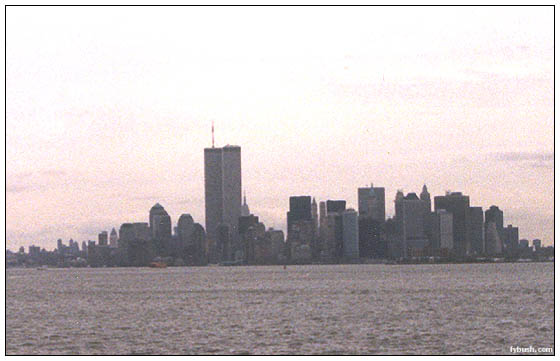
The World Trade Center disaster awakened the
broadcast community to the reality that even the
unthinkable can happen - the tallest building in the
biggest city in the nation can simply be wiped off the
map in the course of two terrible hours, taking with it
most of the market's television infrastructure.
While analog television in New York was nearly "back
to normal" from interim facilities at Empire by
Thanksgiving, the city's broadcasters knew that a
long-term solution to accomodate analog and digital TV
would require a new tower, at least 1400 feet tall.
Since the Trade Center towers were unlikely to be
rebuilt at their old height (and indeed, any rebuilding
at that site seems years off at the earliest), the
broadcasters began exploring the possibility of a new,
more limited-use tower at a different site, forming the
Metropolitan Television Association to carry out the
planning.
Several sites were considered, including Governors
Island off the southern tip of Manhattan; problems with
short-spacing, air-traffic patterns and with local
government approval have focused the MTVA's attention on
possible sites on the New Jersey side, particularly at
Liberty State Park in Jersey City or in nearby
Bayonne.
Even a broadcast-only tower will still take at least
a year, and likely much longer, to get built; in the
meantime the DTV dial in New York remains barren, with
WCBS-DT and WNYW-DT from Empire as the only full-power
signals in Manhattan. Of the broadcasters whose DTV
signals had been at the Trade Center, only WNET-DT on
channel 61 has returned to the air, at low power from a
rooftop near Times Square.
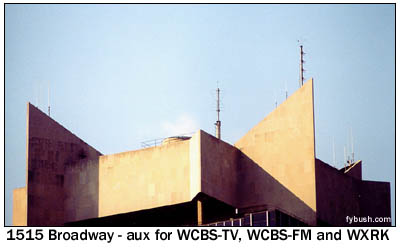 After
September 11, broadcasters also realized that the need
for an auxiliary site at a separate location was more
than just theoretical. After
September 11, broadcasters also realized that the need
for an auxiliary site at a separate location was more
than just theoretical.
WCBS-TV moved quickly to create a backup to its
Empire site, now that the Empire facility was itself the
primary transmitter. In the spring of 2002, channel 2
put up a batwing antenna on the roof of 1515 Broadway,
the Times Square headquarters of parent company Viacom,
to use as a 1 kW backup facility. The 1515 Broadway
rooftop had already been home to an auxiliary antenna
for Viacom's WLTW (106.7), later replaced by Infinity's
WCBS-FM (101.1) and WXRK (92.3) after Viacom sold WLTW
to Clear Channel and merged with CBS/Infinity. (You can
see the batwing in the middle of the photo; the FM aux
is on one of the "wings" of the building to the
right.)
The Armstrong tower will have an important role to
play as an auxiliary site as well; the temporary
facilities of WNBC, WABC, WPIX and WNET there are
remaining in place for future emergency use. If there
ever is a "next time," New York's broadcasters will be
more prepared for it.
It's been a long and challenging year for New York's
TV and FM stations, one they hope never to repeat.
Someday - someday soon, we hope - all of the city's
signals will again transmit at full power from a new
tower site somewhere. When that day comes, we hope the
six engineers who gave their lives high atop the World
Trade Center that September morning will be
appropriately remembered - and we hope due credit will
be paid to all of the engineers, vendors, lawyers and
FCC staffers who worked so hard last fall to restore
broadcast service to New York City.
And speaking of due credit:
This NERW Special Report owes
much to Michael Ravnitzky of American Lawyer Media,
whose Freedom of Information Act request turned up
many of the never-revealed details of the FCC's
special temporary authorizations issued in the wake of
9/11. His FOIA request also turned up copies of the
special issues that NERW put out last September -
which led him to us, and made it possible for us to
share this information with you. Thanks, Michael (and
thanks to the FCC for reading and filing our reports
each week!)
The rest
of the week's news: In
MASSACHUSETTS, Costa-Eagle made the swaps on its
Merrimack Valley AMs last weekend. The English-language
talk that had been on WCCM (800 Lawrence) moved to the
former WHAV (1490 Haverhill), with WHAV changing calls
to WCCM. (What happens to listeners in Lowell who tuned
into WCCM for Spinners baseball and other programming?
They can't hear 1490 there - in fact, it doesn't even
serve Lawrence well - and it's likely the Spinners will
change stations next year.)
 WHAV's "Radio
Impacto" Spanish-language news-talk moves down the dial
to daytimer WNNW (1110 Salem NH), which changes calls to
WCEC ("Costa Eagle Communications"), while WNNW's
Spanish tropical format and call letters move to
Lawrence and the AM 800 signal. WHAV's "Radio
Impacto" Spanish-language news-talk moves down the dial
to daytimer WNNW (1110 Salem NH), which changes calls to
WCEC ("Costa Eagle Communications"), while WNNW's
Spanish tropical format and call letters move to
Lawrence and the AM 800 signal.
A big change in the Boston TV
market, even if the station in question is across the
line in New Hampshire: NBC is buying WPXB (Channel 60)
in Merrimack, N.H. from Lowell Paxson for a reported $26
million. The station, which now carries ShopNBC, will
switch to NBC-owned Telemundo eventually, joining
WTMU-LP (Channel 32) in Boston with the network feed.
(Paxson's son Devon owns WWDP, channel 46 in Norwell,
which had been carrying Telemundo until switching to
home shopping earlier this year.)
One bit of Boston news: Diana
Steele moves from WBMX (98.5 Boston) weekends to WQSX
(93.7 Lawrence) afternoons, while former Hartford PD
Mike McGowan gets the 10 PM-2 AM shift on
Star.
And the FCC has released a new
list of LPFM applications that are approved for filing.
These are all uncontested and technically possible, and
will thus be approved unless objections are filed.
(Which reminds us: aren't LPFM owners limited to one
station per owner? What's up with the "Assembleia de
Deus," anyway?)
- 92.5 Dennis
Assembleia de Deus
Dennis/Boston
- 96.1 Rockport
Assembleia de Deus -
Ministeria do Belem de Annisquam
- 96.9 Worthington
Worthington Educational
Broadcasters
- 97.1 Pittsfield
Housatonic Educational
Radio Fellowship
- 97.7 E. Harwich
Cape Cod Christian
Broadcasting
- 97.7 Great Barrington
Berkshire Community
Radio Alliance
- 98.1 N. Brookfield
Quabbin Educational
Radio
- 98.7 Blandford
Pioneer Valley Planning
Commission
- 98.7 Hinsdale
Hilltown Educational
Radio
- 103.1 Shutesbury
Sirius Community
- 104.3 Pittsfield
Talking Information
Center
- 104.7 Dalton
Berkshire Educational
Radio
- 105.3 Montague
Montague Community
Cable
- 105.5 Chicopee
Assembleia de Deus de
Chicopee/Boston
- 106.1 Worcester
Assembleia de Deus de
Boston/Worcester
That's a lot of Western
Massachusetts signals, isn't it?
*There's a new signal in
MAINE, as we hear reports that Daniel Priestley
has turned on the first of his three new AMs around
Bangor. WNZS (1340 Veazie) is doing CNN Headline News,
we're told.
Is Mariner adding to its "W-Bach"
network? It's paying Gopher Hill $1.15 million for
standards WBYA (105.5 Islesboro), which overlaps plenty
with classical WBQX (106.9 Thomaston).
WTOS (105.1 Skowhegan), already
one of the Pine Tree State's biggest FM signals, will
get even stronger: it's been granted a slight power and
height boost, from 50 kW at 2430 feet AAT to 57 kW at
2450 feet.
And Brunswick will soon be the
test bed for an experiment in third-adjacent spacing.
The FCC has hired a company called Comsearch to do the
"testing" to determine whether 100-watt LPFM signals can
coexist with full-power signals 600 kHz away; a 100-watt
signal on 97.3 in Brunswick will be tested against WCME
(96.7 Boothbay Harbor).
(NERW's comments: We've raged
before about the inanity of the third-adjacent rules,
and we'll keep on doing it. Look at Newton, where WZBC
90.3 is just down the road from full class B WBUR
(90.9). Look at Corning, N.Y., where WSQE (91.1) shares
a tower with a co-owned translator on second-adjacent
90.7. Look at Toronto, where CFXJ (93.5) gets along just
fine with super-B CBL-FM (94.1) on the CN Tower nearby.
The real-life evidence that third-adjacent spacing works
is out there, and there's no need for another series of
"tests." But it's all about the politics, not the
engineering reality...)
*Up in NEW HAMPSHIRE, talk
WNTK-FM (99.7 New London) parts ways with morning host
Pete Ferrand, who's looking for a new gig after more
than five years. Ferrand's background includes WKBK in
Keene, WLLH in Lowell, Utica's WIBX and Rockland's WRKL;
reach out to him at petef@sprynet.com.
There's one LPFM on the FCC's
latest list from the Granite State: 101.1 Bartlett will
be granted to the Jackson Ski Community Radio
Association unless there's serious
objection...
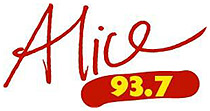 *In VERMONT, WLKC
(103.3 Waterbury) has stopped stunting and is now
simulcasting sister modern AC "Alice" WXAL (93.7
Addison), improving the format's reach into
Burlington. *In VERMONT, WLKC
(103.3 Waterbury) has stopped stunting and is now
simulcasting sister modern AC "Alice" WXAL (93.7
Addison), improving the format's reach into
Burlington.
Down in Brattleboro, WKVT-FM
(92.7) has been granted its on-channel booster across
the river in Keene, N.H. WKVT-FM-1 will operate from the
towers of AM 1290, still legally WKNE but soon to be
WKBK.
*One RHODE ISLAND note:
WOON (1240 Woonsocket) has been granted a permanent
license to keep using its diplex on the WNRI (1380)
tower; that operation had been under STA until
now.
*A surprise station sale in
CONNECTICUT, as John Fuller adds WKCD (107.7
Pawcatuck) to his WBMW (106.5 Ledyard) and WJJF (1180
Hope Valley RI) in the Groton-New London area; no word
on how much Fuller is paying to buy the CHR station from
AAA Entertainment.
Those LPFM tests will take place
in Avon, as well, where Comsearch will run 100 watts on
107.5 to test interference to WCCC-FM on
106.9.
*The big news from NEW YORK
is ABC's $78 million purchase of WEVD (1050 New
York) from the Forward Association, exercising the
buyout provision of the LMA under which ABC had been
operating WEVD since last year. The move takes Forward
out of New York broadcasting for the first time since
the 1920s. ABC continues to lease WQEW (1560) from the
New York Times Co. for Radio Disney...
Heading upstate, WRIP (97.9
Windham) has been granted its booster. WRIP-1 will
operate from Hunter Mountain, filling some gaps in the
RIP's southern signal.
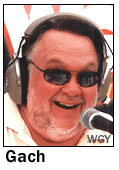 What's up with afternoons
at WGY (810 Schenectady)? We keep getting e-mail about
the mysterious disappearance of J.R. Gach from the
timeslot, which Ed Martin is filling for now - and we
don't have many answers. Clear Channel isn't talking
about what happened to Gach, or whether he'll be back,
and his picture has disappeared from the WGY Web
site... What's up with afternoons
at WGY (810 Schenectady)? We keep getting e-mail about
the mysterious disappearance of J.R. Gach from the
timeslot, which Ed Martin is filling for now - and we
don't have many answers. Clear Channel isn't talking
about what happened to Gach, or whether he'll be back,
and his picture has disappeared from the WGY Web
site...
Four LPFM applications made the
FCC's list from the Empire State:
- 98.7 Colonie
Colonie Educational
Radio Services
- 103.9 Kingston
Kingston Outreach
Services
- 105.9 Utica
Planet Utica
- 107.9 Ellenville
Ellenville Central
School District
And a couple of Rochester notes:
Andrew Langston transfers his WDKX (103.9 Rochester) to
the "Langston Family, LLC." From the "Where are they
now?" files, former WROC-TV (Channel 8) chief
photographer Scott Orr can now put "news director" in
front of his title - after a stint at the assignment
desk of KTVK in Phoenix, he's just been named ND at KFBB
in Great Falls, Montana!
 *Just across
from Buffalo, there's some noise being stirred up in
CANADA over the new format at CKEY-FM (101.1 Fort
Erie). "Wild 101," programmed in Buffalo at Citadel,
made its debut last Friday afternoon - and quickly drew
complaints about its playing of unedited rap songs. The
CRTC (and presumably the Canadian Broadcast Standards
Council) are investigating; meantime, Wild is reaping a
publicity bonanza in Buffalo. *Just across
from Buffalo, there's some noise being stirred up in
CANADA over the new format at CKEY-FM (101.1 Fort
Erie). "Wild 101," programmed in Buffalo at Citadel,
made its debut last Friday afternoon - and quickly drew
complaints about its playing of unedited rap songs. The
CRTC (and presumably the Canadian Broadcast Standards
Council) are investigating; meantime, Wild is reaping a
publicity bonanza in Buffalo.
We were in Niagara Falls last
Friday morning to hear travelers information CFLZ
(105.1) move its programming down the dial to CJRN
(710), while CFLZ became the new home of the modern AC
"River" format that had been on 101.1. As "105.1 the
River," CFLZ is running stereo for the first time,
albeit with a signal that doesn't really go south into
Buffalo; the travelers information on 710 now reaches
most of western New York and southern Ontario,
meanwhile!
Down the road in St. Catharines,
CHSC (1220) has parted ways with GM Doug Setterington
and PD Ted Yates, reports Milkman Unlimited.
In Toronto, Kevin Fox is the
latest to occupy the PD chair at urban CFXJ (Flow
93.5).
Students in Kingston are mourning
Austin Lowe, the former advisor to high school station
CKVI (91.9). He died September 4 of a heart attack; no
replacement has been named.
Up in Ottawa, they're saying
goodbye to CFRA (580)'s Janice Dean. She's headed down
to New York to become part of the cast of the Don Imus
Show.
And in Sudbury, we hear CIGM
(790) was admonished by the CRTC for leaving its daytime
pattern on all night. Been hearing CIGM's country music
down in the U.S.? You won't hear it as well anymore;
we're told the station has fixed its long-broken
equipment to switch to a directional pattern at night,
aimed away from the States.
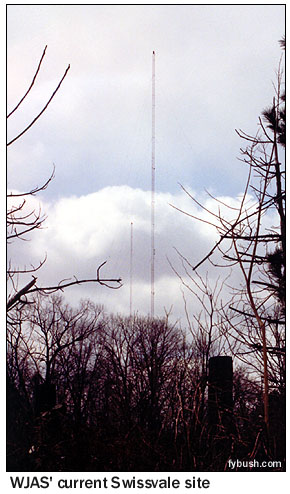 *In PENNSYLVANIA,
WJAS (1320 Pittsburgh) has been granted a CP to make
its long-awaited tower move. *In PENNSYLVANIA,
WJAS (1320 Pittsburgh) has been granted a CP to make
its long-awaited tower move.
WJAS will move from its current
two-tower site near the Squirrel Hill Tunnel to a piece
of land in northwestern Allegheny County, at Highland
Drive and Leech Farm Road near Penn Hills. The station
will run 6000 watts day, 3300 watts night from a new
three-tower array.
Over in Covington, on US 15
between Corning and Williamsport, WDKC (101.5) has been
granted a tower-site change. The little country station
moves north and west, raising power to 1900 watts from
1450 watts and lowering its antenna slightly; the effect
should be at least some signal as far north as the
Elmira-Corning market.
While we're up that way, we note
that the FCC has flagged Backyard Broadcasting's
purchase of the SabreCom group in Williamsport (WWPA,
WBZD-FM, WCXR/WZXR, WILQ and WSFT) for
market-concentration review; since the stations are all
coming from one owner, we'd be surprised if this piece
of the $42 million deal doesn't go through sooner or
later.
Over in Scranton, WAAT (750
Olyphant) hires former WLYC (1050 Williamsport) GM Sam
Jordan as its new general manager; expect a format
change at this religious/standards/leased-time outlet
soon!
*And that's it for the week; back
next Tuesday (Sept. 17) with more, and then we're
back to Monday publication on Sept. 23.
NorthEast Radio Watch is made possible by
the generous contributions of our regular readers. If
you enjoy NERW, please click here to
learn how you can help make continued publication
possible. NERW is copyright
2002 by Scott
Fybush. | 
